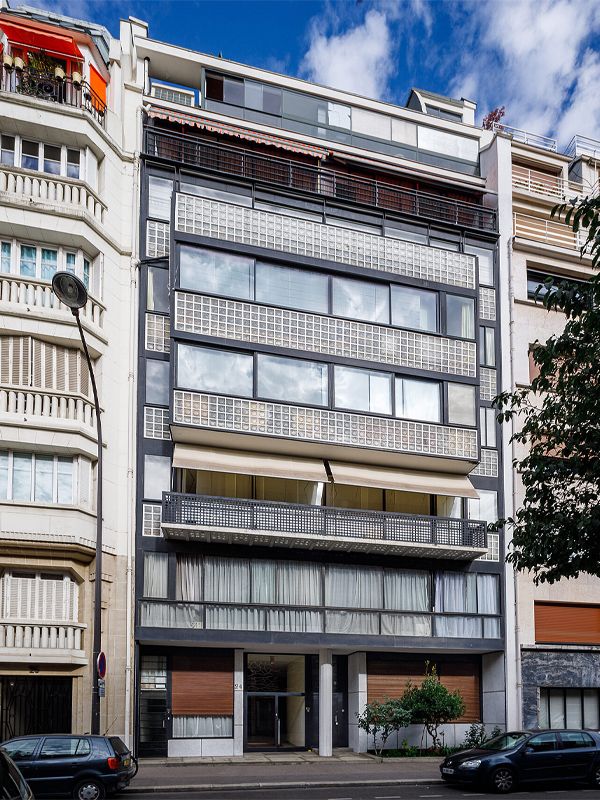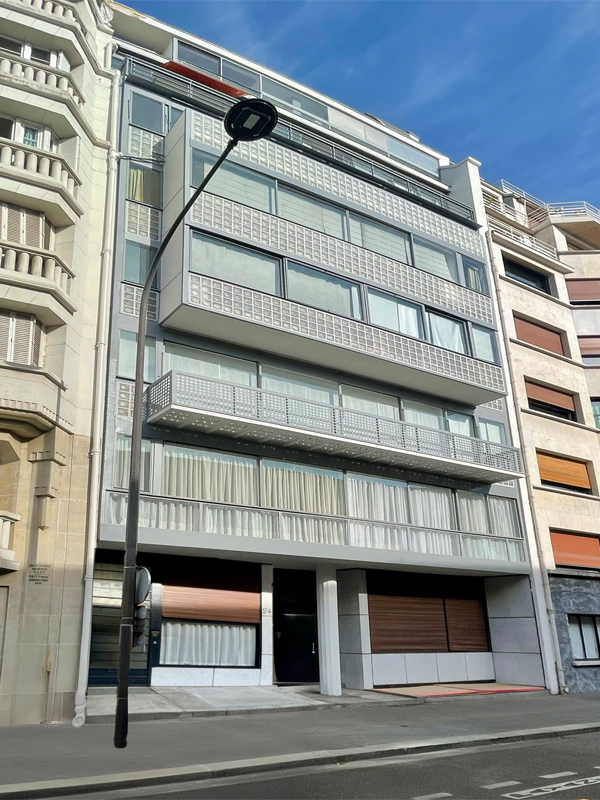
Experts in Le Corbusier’s architectural work have expressed their deep concern at recent works carried out without consultation and without taking into account the opinions of experts and specialists in the restoration of contemporary architecture. The work in question concerns the facade at 24 rue Nungesser et Coli of the Immeuble à la Porte Molitor, between the 16th arrondissement of Paris and Boulogne-Billancourt. This intervention, and in particular the choice of colors, significantly alters the known state of the facade of this building, whose top two floors were occupied by Le Corbusier between 1934 and 1965.
This work is set to resume in autumn with the restoration of the Boulogne-side façade, 23 rue de la Tourelle. The Fondation Le Corbusier, holder of the moral rights and guarantor of the integrity of Le Corbusier’s work, hopes that discussions with the experts, as well as the study of the reports and documents gathered, will enable in the future a collective validation of the choices made by the project manager.
Antoine Picon, President of the Fondation Le Corbusier
Open letter from the experts of the Fondation Le Corbusier
July 2024
The scaffolding that recently stood at 24, rue Nungesser-et-Coli has been dismantled. The partly restored facade of the Immeuble Molitor now has a new look, the state of 1965, which was the last time it was restored during Le Corbusier’s lifetime. The choice of “restitution”, if not supported by convincing evidence as to its reference state, and if its implementation is not carried out with the utmost care for the original material, demonstrates the limits of this major deontological option. The facade is very pale, not because the interventions were insignificant, but because the design of the metal elements, which Le Corbusier and Pierre Jeanneret liked to emphasize because they encircled the light volumes, have a very light grey tint, RAL 7037, proposed and then literally imposed by the project manager against the advice of the Fondation Le Corbusier and its experts, architects, conservators, restorers, chemists, etc. The tint will certainly have replace the unfortunate black tint hastily applied previously. But this choice appears arbitrary, insufficiently attested by the rich historical documentation made available by the Fondation Le Corbusier, nor by a campaign of stratigraphic studies as colossal as they are incomprehensibly incomplete.
The Fondation Le Corbusier has not been listened to, in the restoration of a building inscribed on the World Heritage List that it particularly cherishes and of which it is part owner and manager, and is probably the jewel of Le Corbusier’s architecture, with its own penthouse apartment-studio. Its research, suggestions, solicitations and proposals for scientific dialogues and historical investigations, in particular of print and iconographic archives, went unheeded, at best manipulated to feed a dossier which, from the very first surveys, took a one-way direction. So here we are, faced with a fait accompli, the urgency of dismantling the scaffolding in the context of the Olympic Games has precluded a lack of prior consultation.
The question that arises is to know and understand how to avoid a situation that convinces no one, the all-too-light grey that will be right before the eyes of the world as part of the series inscribed on the World Heritage List, for some time to come. How can we ensure that the correction, if not the excellence that the Immeuble Molitor deserves, is respected in the restoration process? That the Fondation Le Corbusier, and the experts it calls upon, who provide serious, well-argued answers to the delicate, always difficult questions posed by the restoration of Le Corbusier’s work, are genuinely listened to and considered by the project manager, and not suspected of being preventing rapid restoration, rather than conserving as scientifically as possible ?
The question of deadlines must surely never be played again. And it is just as important to ensure that all those involved in a restoration project of this magnitude work together to determine the right shades of paint before the project begins, as should be the case in all proper restorations of buildings of much lesser value. This is a basic rule that was not respected here, resulting in a highly questionable choice and an unpleasant situation of confiscated authority. The absence of an overall strategy established in advance of the project for the chromatic treatment and conservation measures of the envelope – the steel fittings, but also the masonry panels, the joints between the Nevada glass blocks, the perforated sheet metal railings – has led to an interpretation of the work that is dubious, to say the least, and highly regrettable.
Our hope is that the restoration of the rear facade of the Immeuble Molitor, scheduled for autumn, will rectify this situation.
Olivier Cinqualbre, honorary curator of the architecture collection, Centre Pompidou
Bénédicte Gandini, architect-historian
Franz Graf, architect and lecturer, USI /EPFL, Lausanne
Marie-Odile Hubert, curator-restorer of painted works, specialising in 20th-century paintings
Richard Klein, architect et professor, Université de Lille
Giulia Marino, architecte et professor, UCLouvain, Bruxelles
Bruno Reichlin, architect, emeritus professor at the University of Geneva, and honorary professor at ETH, Zurich
Arthur Rüegg, emeritus professor at ETH Zurich
Jacques Sbriglio, architect

